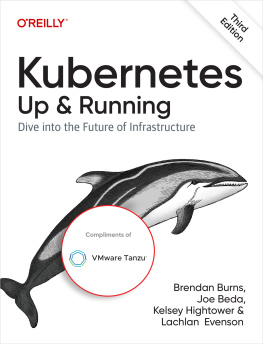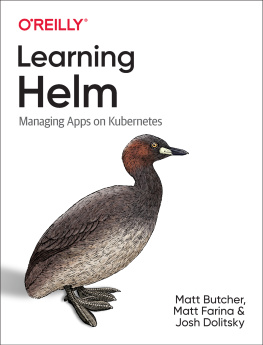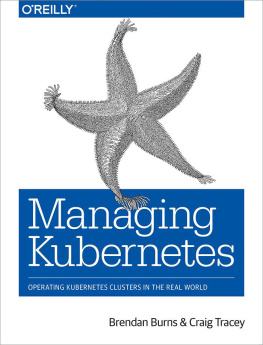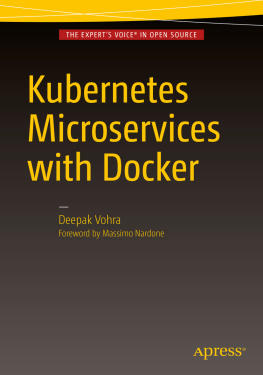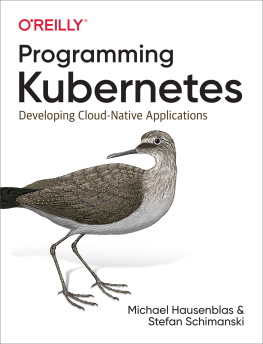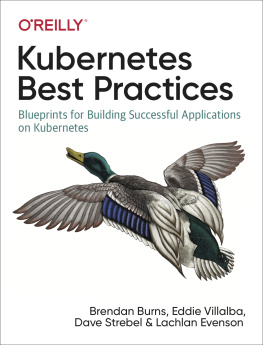Kubernetes
7-Day Guide for Easy Understanding of Kubernetes for Developers and IT Professionals
Akash V.P.
Copyright 2019 - All rights reserved.
The content contained within this book may not be reproduced, duplicated or transmitted without direct written permission from the author or the publisher.
Under no circumstances will any blame or legal responsibility be held against the publisher, or author, for any damages, reparation, or monetary loss due to the information contained within this book. Either directly or indirectly.
Legal Notice:
This book is copyright protected. This book is only for personal use. You cannot amend, distribute, sell, use, quote or paraphrase any part, or the content within this book, without the consent of the author or publisher.
Disclaimer Notice:
Please note the information contained within this document is for educational and entertainment purposes only. All effort has been executed to present accurate, up to date, and reliable, complete information. No warranties of any kind are declared or implied. Readers acknowledge that the author is not engaging in the rendering of legal, financial, medical or professional advice. The content within this book has been derived from various sources. Please consult a licensed professional before attempting any techniques outlined in this book.
By reading this document, the reader agrees that under no circumstances is the author responsible for any losses, direct or indirect, which are incurred as a result of the use of information contained within this document, including, but not limited to, errors, omissions, or inaccuracies.
Table of Contents
Chapter 1: Introduction and Basic Concepts
Kubernetes, also known as k8s, is an open-source system used for the automation of deployment, scaling, and management of containerized applications across a cluster of hosts. It was designed by Google initially in 2014 and is currently maintained by the Cloud Native Computing Foundation. So, what does Kubernetes actually do, and where to use it? Well, it is a vendor-agnostic cluster and a container management tool.
The origin of the word Kubernetes is Greek. K8s means k followed by 8 characters and then s or Kube. It eliminates many of the manual processes involved in the scaling and deployment of containerized applications. You can create a cluster of groups of Linux container hosts and Kubernetes will aid you in managing them easily and more efficiently.
Kubernetes enables the software teams of all sizes, including the small start-ups to Fortunes 100 companies for automating. The applications may include anything from internal facing web applications, such as a CMS (Content Management System), to marquee the web properties, such as Gmail, for big data processing.
For instance, let's say that the application environment is an old school lunchbox. Its content was well-assembled before putting it into the box but there wasnt any isolation placed between any of the contents of the lunchbox. Kubernetes provides a lunchbox which allows you just in time expansion of the contents (this is called scaling) and complete isolation of all unique items in the box. It also comes with immutability, which is the ability to remove the items without affecting other contents of the box.
The Need for Containers and Kubernetes
Before explaining what Kubernetes does, it is important to understand what the containers are, and why people are using them. A container is a small scale virtual machine. It is mini as it does not come with device drivers and other components of regular virtual machines. The most popular container by far is Docker and it is written by Linux. Microsoft has also added containers to their Windows as they have become quite popular. The best way of illustrating their use and significance is by giving an example.
For instance, if you wish to install an Nginx web server onto a Linux server, there are many methods of doing it. Firstly, you may install it directly on the OS of the physical server; however, most people use virtual machines these days, therefore, you may install them as well. Setting up the virtual machines need some administrative efforts and costs also. Another problem is that the machines will be underutilized if you focus them on just a single task, and this is how most people use virtual machines.
It is a better idea to load the machines up with Nginx, a DNS server, and messaging software. People who invented these containers considered these issues and opined that as Nginx or any other applications need a bare minimum OS for running. In that case, why not make a stripped-down edition of an OS, place Nginx inside it and run it. Now, you will have a self-contained and machine agnostic unit which can be installed anywhere. These containers are so popular these days that they are threatening to make VMs obsolete.
Microservices with Docker Hub
Microservices is a popular architecture used for building large-scale applications. Instead of using a single, monolithic codebase, these applications are broken down in a collection of small components called microservices. Docker is an excellent tool used for managing and deploying the microservices.
The reduction in the size of the container is not their only advantage. Containers can be deployed like VM templates. It means an application that is ready to go will require just a bit or no configuration. You can see thousands of preconfigured Docker photos at Docker hub - the public repository. Here, people have taken the time to create some open-source software configurations which may take many people hours or days for putting together. Many people benefit from that as they can install Nginx or some even more complex items just by downloading them from here.
For instance, the one live command that follows will down, install, and restart the Apache Spark, including the Jupyter notebooks also known as iPython.
docker run -d -p 8888:8888 jupyter/all-spark-notebook
As you might have observed, it's running on port 8888, therefore, you may install something else on other ports or even install another instance of Spark and Jupyter.
Need for Orchestration
However, there is an inherent issue with the containers much similar to the case of virtual machines, and that is keeping track of them. When the public cloud organizations are billing you for CPU time or storage, you need to ensure that you dont have any orphan machines there which do not do anything. In addition to that, there is the need to automatically spin up more if the machine needs extra memory, storage, or CPU, as well as shutting them down when the load has lightened. Orchestration gets rid of these issues and this is where Kubernetes comes in.
Kubernetes Basics
Google is using Kubernetes since it built the platform some 15 years ago. The very fact that Kubernetes has been used to run the massive systems of Google for that long is the biggest selling point of the platform. Google, a few years back, pushed it into becoming an open-source platform. Kubernetes allows you to deploy clusters, meaning a network of VMs, and it works with various clusters including the Docker.
The fundamental idea here is to abstract the machines further, including the storage and networks, away from the physical implementation; therefore, it is one single interface that can be used to deploy containers for various kinds of clouds, VMs, and physical machines. Here are some basic concepts of Kubernetes, which will help in understanding what it does.
Node
A physical or a virtual machine is also called a node. It is not created by Kubernetes and they are developed by using cloud Oss, such as OpenStack or Amazon EC2, or you need to install them manually; therefore, you must lay down the fundamental infrastructure before you can make use of Kubernetes for deploying your apps. However, from that point on, it is capable of defining virtual networks, storage etc. For instance, you may use Open Stack Neutron or Romana for defining networks and sort of push them out from Kubernetes.


